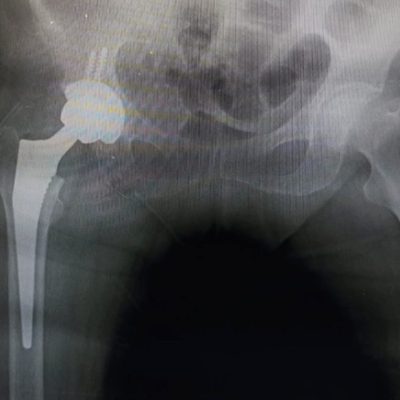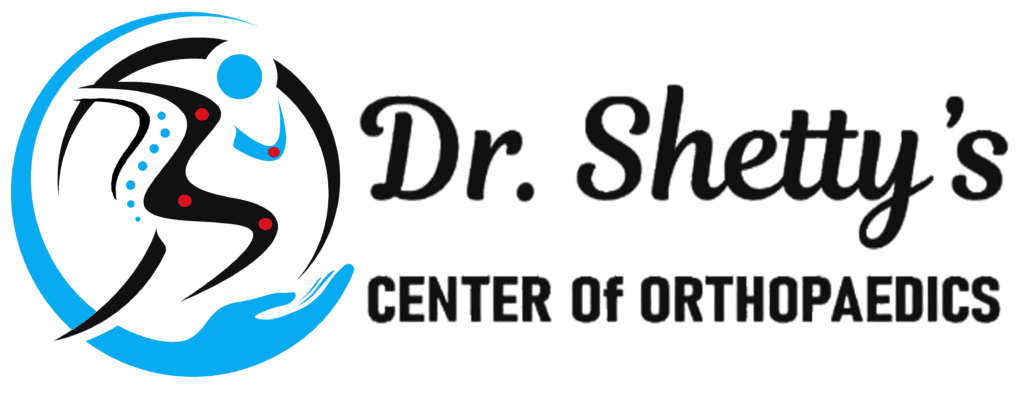Dr. Akshay Shetty Orthopaedics
Total Hip Replacement in HSR Layout
Total Hip Replacement
Hip replacement surgery, or hip arthroplasty, is a surgical procedure in which an orthopaedic surgeon removes the damaged or diseased parts of the hip joint and replaces them with prosthetic components.
The hip joint consists of a ball (at the top of the femur, also known as the thigh bone) and a socket (in the pelvis, also known as the hip bone). Total hip replacement surgery includes the replacement of both parts.
The damaged femoral head is removed and replaced with a metal stem (Co- -Cr alloy) that is passed and placed into the hollow canal of the femur (thigh bone). The femoral stem is fixed to the femur with the help of bone cement or by the usage of a Hydroxyapatite (HA) coated “press fit” stem which promotes bone ingrowth and natural fixation to the surrounding bone

• A metal (Co- -Cr alloy) or ceramic ball is placed on the upper part of the femur stem. This ball replaces the damaged femoral head that was removed.
• The damaged cartilage surface of the socket (acetabulum) is removed and replaced with a metal socket. Screws or cement are sometimes used to hold the socket in place.
• A polythylene or ceramic spacer (also called a liner) is inserted between the new ball and the socket to allow for a smooth gliding surface.
Indications-
Osteoarthritis of the hip joint- Arthritis of the hip joint may be due to age-related wear & tear of the joint surfaces
AVN (Avascular Necrosis) Hip- This is a condition where bone cells of the femur head (the upper most ball of the thigh bone) start to die due to blockage in the blood supply. This blockage may be due to excessive alcoholism, excessive steroid intake, blood coagulation disorders, sickle cell anaemia etc. Due to this event bone below the joint surface starts collapsing leading to arthritis. Early stages of AVN can be managed with a minimally invasive procedure called core decompression without the use of bone marrow stem cell therapy. Later stages can only be treated with Total hip replacement for a stable, painless and functional knee.
Tuberculosis hip
Arthritis of the hip due to destruction of joint surfaces secondary to septic infection (most commonly childhood infection)
Arthritis of the hip due to childhood disorders like Perthes disease, SCFE (Slipped Capito Femoral Epiphyses), DDH( Developmental dysplastic hip)
Fractures around the hip joint in elderly active individuals, where fixation of the fracture would not be possible or would fail. The neck of the femur fracture is the most common fragility fracture encountered, followed by acetabulum fracture and pipkin’s (femur head) fracture.
Procedure-
This procedure is done under spinal or general anaesthesia according to the patient’s general condition or patient’s choice. Operation is done in a position where the patient’s diseased hip is facing up.
Femur component fixation to the bone-
The metal ball has a stem in an ice cream cone fashion which is inserted into the femur bone in a press-fit fashion after the removal of the worn and torn head of the femur bone. Fixation of metal stems to the bone can be done either by using cement or hydroxyapatite (HA) coated metal stems ( HA promotes bone ingrowth and helps in the natural biological fixation of metal implants to bone). Nowadays we prefer using the latter one as it is more biological and we get a robust fixation.
Acetabulum Component fixation to the bone-
After the worn and torn portion of the acetabulum (socket bone) has been scraped out, fixation of ultra-high molecular weight polyethene which is backed by a Co-Cr metal socket is fixed to the bone using a press fit manner. The metal socket also has pegs (hooks) which help in additional stabilization.
Post Surgery-
Patients are started on physical therapy involving passive stretches and active assisted exercises from the next day of surgery. Patients are encouraged to be up and out of bed from the next day of surgery. Patients are made to put on full weight and walk with the help of Walker. Discharge is planned after 2-4 days of surgery. Routine activities of daily living can be resumed soon after patients go home with minimum assistance in the initial 2-3 weeks followed by no assistance. Patients are not supposed to sit on low-lying chairs & on the ground, not to use Indian toilets, and not to sleep in a lateral position on the operated hip for the initial 3 months. Patients are supposed to keep a pillow between 2 legs to maintain abduction when they sleep. Driving can be resumed after 3-4 months of surgery.
Top Hip Surgeon in HSR, BTM layout and Koramangala
Dr Akshay Shetty is highly recommended for Total Hip Replacement, known as top hip surgeon for his exceptional skill in total hip replacement and other hip procedures. If anybody looking for the same visit at Dr. Shetty’s Center Of Orthopaedics based in HSR layout, BTM and Koramangala
